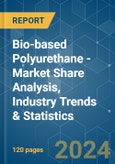The Bio-based Polyurethane Market size is estimated at 10.30 kilotons in 2024, and is expected to reach 20.49 kilotons by 2029, growing at a CAGR of 14.73% during the forecast period (2024-2029).
This product will be delivered within 2 business days.
Key Highlights
- The market was negatively affected by the COVID-19 pandemic. The construction industry was significantly impacted during the pandemic, which affected the demand in the market studied. However, the market is excepted to retain its growth trajectory in the coming years. Currently, the market has recovered from the pandemic and is growing at a significant rate.
- Over the mid-term, the key factors driving the market studied are the increasing demand from the construction industry in developing countries and the increasing demand from electronic appliance manufacturing.
- However, the high cost of bio-based materials is expected to hinder the growth of the market studied.
- Nevertheless, industrial growth in the Middle East and Africa is expected to act as an opportunity during the forecast period.
- The Asia-Pacific region is expected to be the fastest-growing market across the world, with the largest consumption from countries such as China and India.
Bio-based Polyurethane Market Trends
Increasing Demand from the Transportation Industry
- Bio-based polyurethane finds its key applications in the transportation industry, including the automotive, railway, and aerospace industries. Moreover, the automotive industry consumes bio-based PU foams, coatings, adhesives, and sealants. Specifically, bio-based PU foams are used in seating systems (headrests, headliners, armrests, seat cushioning, and others) and interior parts.
- According to Organisation Internationale des Constructeurs d'Automobiles (OCIA), global automotive production reached 85.02 million units in 2022. The production capacity increased by 6% compared to 2021. In 2022, China, the United States, and Germany were the top three manufacturers of cars and commercial vehicles.
- Asia-Pacific, the largest automotive production region, also witnessed a growth rate of 7% in 2022. The production increased from 46.76 million in 2021 to 50.02 million in 2022, respectively. Similarly, America and Africa witnessed 10% and 13% growth rates, respectively, in 2022.
- In the railway industry, bio-based PU has potential applications, as it can replace conventional PU products by a significant amount in the coming years. In railways, bio-based foams can be used in seat cushioning and thermal insulation applications.
- The Indian Railways were predicted to expand with government ingenuity since they were the third biggest railway industry in the world under a single management. According to the India Brand Equity Foundation, the equivalent of USD 124 billion was projected to be invested in the country's railroads between 2018 and 2022, one of 34 infrastructure sub-sectors.
- Furthermore, in the aerospace industry, bio-based PU foams and coatings can substitute conventional PU materials. According to Boeing, the size of the worldwide aerospace services industry is anticipated to exceed USD 3.6 trillion between 2022 and 2041, with the United States and Canada accounting for around 30% of that total, followed by Europe with 23.5 percent of the market.
- Therefore, the demand in the transportation industry is expected to increase the demand for bio-based polyurethane during the forecast period.
Asia-Pacific Region is Expected to be the Fastest Growing Market
- Asia-Pacific is the largest producer of bio-based polyurethane, with a high abundance of synthetic diisocyanates and a large number of bio-based polyurethane in the region.
- Bio-based polyurethane is utilized in construction. It is increasingly utilized for window and door profiles, pipes and guttering, cement, flooring, glass, sealants and adhesives, insulation, building panels, and roofing.
- China is amid a construction mega-boom. The country has the largest building market in the region and the world, making up 20% of all construction investments globally. The Chinese government is estimated to have an annual limit for new infrastructure bonds worth CNY 3.85 trillion (USD 0.54 trillion) in 2022, up from CNY 3.65 trillion (USD 0.52 trillion) in 2021.
- Bio-PU is capable of replacing polypropylene in automotive applications such as bumpers and bumper spoilers, lateral siding, roof/boot spoilers, rocker panels, body panels, dashboards and dashboard carriers, door pockets and panels, consoles, heating ventilation air conditioning, battery covers, air ducts, pressure vessels, and splash shields.
- According to Organisation Internationale des Constructeurs d'Automobiles (OICA), around 27.02 million vehicles were produced in China in 2022, compared to 26.12 million vehicles produced in 2021, witnessing a growth rate of about 3%.
- In addition to its electrical insulation, shock resistance, adhesion, and other qualities, bio-based polyurethane is also widely utilized in electrical and electronic applications such as cell phones, mobile devices, computers, and TVs.
- Similarly, in India, the electronics market witnessed a growth in demand, with market size increasing at a rapid growth rate. The Ministry of Electronics and Information Technology published the second volume of the Vision document on Electronics Manufacturing in India, which predicted that the electronics manufacturing industry in India would grow from USD 75 billion in 2020-21 to USD 300 billion by 2025-26. The growing electronics and appliances markets in India and China may push the market growth further in Asia-Pacific.
- The aforementioned factors are likely to increase the demand for bio-based polyurethane during the forecast period.
Bio-based Polyurethane Industry Overview
The bio-based polyurethane market is consolidated in nature. The major manufacturers in the market studied include BASF SE, Covestro AG, Huntsman International LLC, Mitsui Chemicals Inc., and The Lubrizol Corporation.Additional Benefits:
- The market estimate (ME) sheet in Excel format
- 3 months of analyst support
This product will be delivered within 2 business days.
Table of Contents
1 INTRODUCTION
4 MARKET DYNAMICS
5 MARKET SEGMENTATION (Market Size in Volume)
6 COMPETITIVE LANDSCAPE
7 MARKET OPPORTUNITIES AND FUTURE TRENDS
Companies Mentioned (Partial List)
A selection of companies mentioned in this report includes, but is not limited to:
- Arkema
- BASF SE
- Covestro AG
- Huntsman International LLC
- Miracll Chemicals Co. Ltd
- Mitsui Chemicals Inc.
- Stahl Holdings BV
- Toray Industries Inc.
- Teijin Limited
- The Lubrizol Corporation
- Woodbridge
Methodology

LOADING...










